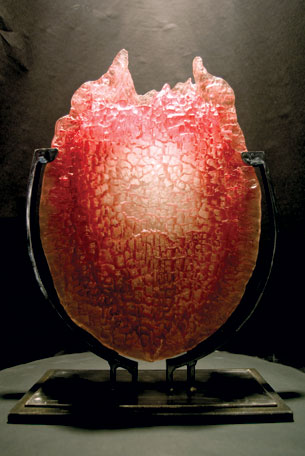Barry Hood’s latest evolution as a glass artist started about 14 years ago as he watched a string of molten glass burn through a 2-by-4 piece of wood at Pilchuck Glass School.
The next day, he poured glass into a hollowed-out log he found outside, creating his favorite piece, “Earth Hart,” and began his journey using an experimental glass-molding technique.
“The first one was so successful,” Hood said. “It’s pretty raw; there’s a huge amount of failure, which I really like.”
Hood’s work is featured in the Hockaday Museum of Art’s newest round of exhibits. His show, “Flow,” as well as local metal smith Wayne Hammer’s intricate jewelry, will take over the museum’s main level from Jan. 6 to March 17.
The museum is also featuring its first annual emerging artists exhibition, “Catch the Vision: From Dreams to Discovery.”
There is an opening reception for all the exhibits scheduled for Jan. 13.
In the newly repainted and reorganized permanent collection room, the Hockaday will feature the works of Montana artist Josephine Hale from Jan. 6 through Feb. 26.
The latest installations are an indication of a new direction for the museum, one that may include more contemporary artists and opportunities to meet the artists responsible for the work.
The idea is to give valley residents a chance to see a different facet of the Hockaday, said Liz Moss, the museum’s executive director.
“We are going to bring in a variety of traditional and contemporary work,” Moss said. “I want to get people excited about coming here again.”
Hood’s work is particularly eye-catching. His exhibit is set in a two-room installation at the museum, which has been transformed with dark walls and direct lighting to illuminate the art.
The first room features pieces from his “Harts” collection. These iconic works are the result of pouring 2,300-degree glass into hollowed wood molds and letting it take shape.
The glass burns the wood as it cools, a process that only stops once the oxygen is cut off. The resulting works are rough, strong, pitted, creased and entirely unique, giving them a life and a look all their own.
 |
|
“Big Red Sun Hart” by Barry Hood at the Hockaday Museum of Art. |
The shapes often resemble anatomical organs, and Hood labels them “harts.”
“When I started working in this process, it became more of a collaboration with nature,” Hood said. “What happens is sort of beyond my control.”
After the molding process, Hood takes the glass back to his studio in Helena and cuts, shapes, sands, smoothes and colors them. Then, if the piece is successful, he creates a stand for it.
“It’s a pretty involved process,” Hood said.
In the second room of the installation, Hood’s work takes on a different facet with some of his “Extinction” pieces. These pieces feature the outlines of leaves and branches in clear glass. Some have Braille poems engraved on their surface, which Hood said are from the 12th and 13th centuries.
“We’re all blind. Most of us are blind to ourselves and we’re most certainly blind to the world we’re living in,” Hood said.
The idea of using Braille was initially borne of condescension, he admits, but it evolved into an appreciation for humankind’s creativity.
“To me, Braille represents the best that mankind has to offer,” Hood said. “They developed this system that allows blind people to read. That’s a pretty cool thing.”
However, anyone interested in taking part of verbal conversation with Hood can attend the “Conversations with the Artists” event. It takes place at 4 p.m. before the opening reception on Jan. 13.
Hood began working with glass in 1974 during his career in architectural etchings. He eventually got a degree in ceramics, and his University of Montana ceramics teacher, Rudy Autio, is a major influence on Hood’s art.
Hood also spent 15 years in Whitefish during the beginning of his career and said he’s excited to revisit the Flathead.
“That’s where my business took off and where I really had some wonderful times and created some really nice things,” Hood said.
He said he hopes people come to see the exhibit at the Hockaday, and that it makes them stop and think.
“If there’s no risk, there’s no art,” Hood said, later adding, “the best art is the art that involves the viewer.”
For more information on the Hockaday Museum of Art and the current exhibits, visit www.hockadaymuseum.org or call 406-755-5268.